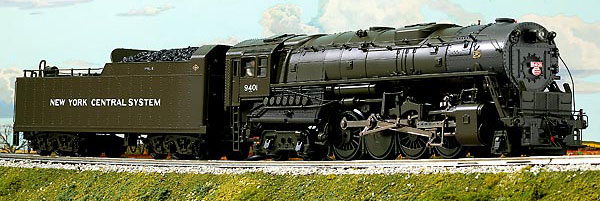The railroad didn’t believe there was a viable diesel on the market that could meet its requirements. So in 1945, the P&LE convinced parent New York Central to begin replacing the H7s, at first with seven new steam locomotives and only later with diesels.
Due to right-of-way restrictions, the locomotives had to be designed with narrow clearances and bridge tonnage limits in mind. Alco began design work in 1947. The end result was a 2-8-4 Berkshire with better operating characteristics than the H7s, but similar to the Mikados in size and weight.
In the meantime, the formerly unconvinced P&LE had a chance to dabble with a pair of Fairbanks-Morse H-10-44 1,000-hp diesel switchers.
The high in-service rate, economy, and operational capabilities of the diesels lifted the cloud from the eyes of management, and the railroad decided to embark on dieselization.
To the surprise of P&LE management, the New York Central wouldn’t let the line cancel the steam order; in fact, the NYC insisted that it buy 10 of the Berkshires. After considerable wrangling, the Central agreed to lower the number to seven.
Alas, as Jack Polaritz noted in his article “The Unwanted Berkshires” in the Spring 2004 issue of Classic Trains, “They never stood a chance of long-term survival, and they were obsolete before they ever left their birthplace.”
Size limitations negated any advantages the Berks had over the Mikados. In 1953, when sufficient diesels arrived, the P&LE retired the locomotives. Two years later, it leased the Berkshires to the NYC, which ran them on the Big Four Lines in Ohio and Indiana.
In 1956, the NYC authorized the P&LE to dispose of the steamers and the last was scrapped by March 1957.
The model
Designed so late in the game, the P&LE Berkshire looks different than many steam locomotives, and MTH uses that to good advantage for this Premier line model.
The boiler nose looks far more blunt and business-like than on most steamers. The pilot comes to a very small point, flanked by oversized foot-rests, and there is a red-tipped brake line. The scale-sized dummy coupler is attached by a chain to the uncoupler arm. There is a wide, flat shield, with intricate cast-in detail, protecting air pumps on the pilot.
The smokebox looks flatter than most – with an engine number and New York Central System plate on the smallish smokebox door. The headlight (with illuminated engine numbers) is bracketed by marker lights.
The boiler has plenty of cast-in rivets, seams, and pipes as well as add-on pipes, valves, and handles. Handrails run along the boiler, and the walks alongside the boiler feature cast-in safety tread.
The all-weather cab has opening doors as well as an open walkway to the tender. It also has firebox glow and interior illumination.
Two crew figures and an array of cast-in, painted gauges make the heart of the locomotive look fabulous. Of course, there are two opening roof hatches as well as opening cab windows.
The tender is a monster that models the Central’s FT-1 rig. The prototype carried 22,000 gallons of water and 22 tons of coal. The model’s tender has plenty of cast-in rivets as well as add-on ladders, builder’s plates, a coil coupler, and a simulated uncoupler arm. The coal load is “chunk-style,” rather than cast-in, and the backup light also features illuminated engine numbers.
The water hatches open to reveal the ProtoSound 2.0 battery charger connection and rotary controls for both sound-system volume and smoke output. The trucks are a delight, and the sideframes have brake chains connecting the frame and the truck.
The prototype A2a was 108 feet, 3 inches long and 15 feet, 2 inches high. This was 7 feet shorter than a comparable S1-class Northern. The model measures 111 feet in O scale (273/4 inches), with the length of the drawbar and the oversized tender coupler accounting for the difference from the prototype.
Painting and decoration are first rate. When the P&LE received the Berkshires from Alco, it made some minor modifications to the decoration of the olive drab locomotive. The railroad changed the lettering from gold to white, and it painted the black firebox a graphite color. Alco applied white sidewalls to the locomotive tires, but the P&LE decided not to maintain that feature.
By the way, the builder’s plate on the tender is from Lima and not Alco. The A2a locomotives were Alco’s last steamers. Since the firm’s tender shop was already closed, Lima was contracted to build the tenders. That’s why there’s a tiny Lima plate on the upper end of the front of the tender and an Alco builder’s plate on the locomotive.
On the test track
Performance of the speed-control equipped Berkshire was superb. Our conventional-control mode low-speed average was 4.2 scale mph, while in the DCS command-control mode the low-speed average was 2.89 scale mph. Our high-speed average was 72.5 scale mph.
Drawbar pull was a studly 4 pounds, 5 ounces.
The locomotive responded quickly to speed changes, whether directed from a DCS controller or the nudge of a throttle handle. Slow-speed movements were ultra smooth, and drawbar pull was surprisingly robust, considering this is a relatively small locomotive.
The various DCS features functioned as expected, and the sound package was excellent. The throaty whistle evoked many a grin, sounding like the Queen Mary pulling into port. Some folks listening to the locomotive weren’t so keen on the bell sound, but you can’t make everyone happy.
The tender is an impressive piece of work. Moving many of the control knobs from the tender frame to its top deck, hidden beneath opening water hatches, is a great move – especially the smoke-unit control.
My only gripe about the tender is that the tether plug does not easily plug into the rear of the locomotive. Or maybe I just need smaller fingers.
I enjoyed running the MTH A2a. I just wish that the prototype could have delivered such good performance!














